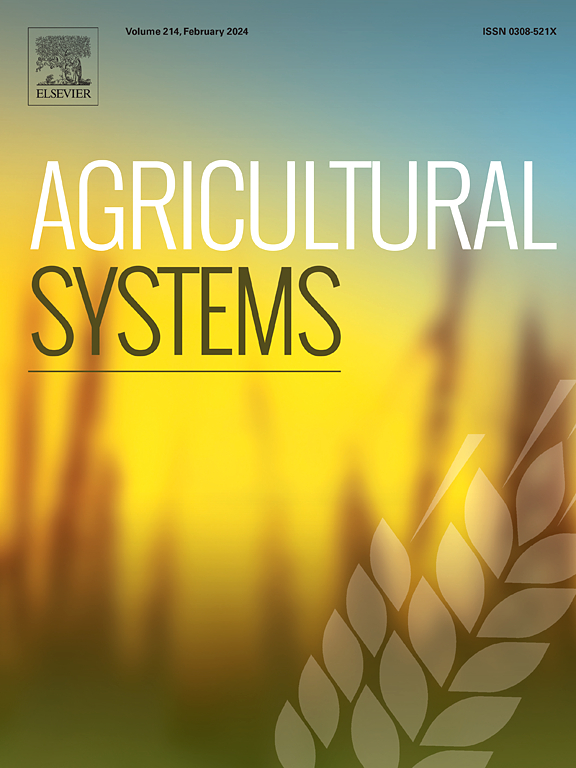审查 APSIM 用于农业系统分析的土壤氮模拟能力
IF 6.1
1区 农林科学
Q1 AGRICULTURE, MULTIDISCIPLINARY
引用次数: 0
摘要
在过去的26年里,全球研究人员成功地将土壤氮(N)模型应用于农业生产系统模拟器(APSIM)中,模拟了多种农业系统和环境下的氮循环及其对作物生产的影响。随着建模社区进一步扩大其关注焦点,包括农业对环境的影响,它需要模型适合这一更广泛的目的。通过不同途径准确模拟N损失需要更多的模型,因此,为了告知和优先考虑未来的发展需求,我们开始对APSIM的土壤N建模能力进行详细审查。方法:我们对APSIM土壤氮模型验证研究进行了全面的检索,并找到了131篇相关的论文,涵盖了广泛的系统、应用和过程。我们考察了他们的方法和发现,从中总结出经验教训。结果和结论尽管土壤氮模型的核心自建立以来变化有限,但模型与数据的比较显示,在所有建模过程中都有很强的表现。该模型采用相对简单的概念池方法来模拟碳(C)动态,并通过碳氮比与N循环联系起来,已被证明是非常通用的。然而,这些概念池对初始化方法和不同时间尺度预测的敏感性提出了挑战,例如长期碳轨迹与短期季节性氮动态。在每日时间步长上正确预测N损失的时间也被证明是具有挑战性的,但这种分辨率可能并不总是必需的。APSIM的适应性代码结构促进了模型原型的创建(例如,氨挥发和径流中的氮),允许在正式发布之前测试不同的概念。意义apsim是应用最广泛的农业系统模型之一。这篇综述涵盖了模型文档、模型数据比较、参数化的各种方法和附加过程的原型,巩固了几十年来对模型及其功能的深入研究。这篇综述强调了在广泛的应用中进行模型评估的重要性,以确保模型的稳健性,识别可能在单一研究中被掩盖的问题,并允许出现具有广泛适用性的解决方案。本文章由计算机程序翻译,如有差异,请以英文原文为准。

Review of APSIM's soil nitrogen modelling capability for agricultural systems analyses
CONTEXT
Over the last 26 years, researchers globally have successfully applied the soil nitrogen (N) model in the Agricultural Production Systems sIMulator (APSIM) to simulate N cycling and its effects on crop production across a range of agricultural systems and environments. As the modelling community further expands its focus to include environmental impacts of farming, it needs the model to be fit for this broader purpose.
OBJECTIVE
Accurately modelling N loss via different pathways demands more of the model and so, to inform and prioritise future development needs, we embarked on a detailed review of APSIM's soil N modelling capability.
METHODS
We conducted a comprehensive search of APSIM Soil N model verification studies and found 131 relevant publications across a wide range of systems, applications, and processes. We examined their approaches and findings, and distilled out the lessons learnt.
RESULTS AND CONCLUSIONS
The model-data comparisons showed strong performance across all modelled processes, despite limited changes to the core of the soil N model since its inception. The model's relatively simple conceptual pool approach to modelling carbon (C) dynamics with N cycling linked via C:N ratios, has proven remarkably versatile. However, these conceptual pools have posed challenges relating to initialisation methods and the resulting sensitivity of predictions at different time scales, e.g. long-term C trajectories vs. short-term seasonal N dynamics. Correctly predicting timing of N loss on a daily timestep also proved challenging, but this level of resolution may not always be required. APSIM's adaptable code structure facilitated the creation of model prototypes (e.g., ammonia volatilisation and N in runoff) allowing testing of different conceptualisations ahead of formal release.
SIGNIFICANCE
APSIM is one of the most widely used agricultural systems models. This review, which covers model documentation, model-data comparisons, various approaches to parameterisation, and prototypes for additional processes, consolidates decades of research into insights about the model and its functioning. The review highlights the importance of model evaluations across a wide range of applications to ensure model robustness, to identify issues that may be masked in single studies, and to allow the emergence of solutions with broad applicability.
求助全文
通过发布文献求助,成功后即可免费获取论文全文。
去求助
来源期刊

Agricultural Systems
农林科学-农业综合
CiteScore
13.30
自引率
7.60%
发文量
174
审稿时长
30 days
期刊介绍:
Agricultural Systems is an international journal that deals with interactions - among the components of agricultural systems, among hierarchical levels of agricultural systems, between agricultural and other land use systems, and between agricultural systems and their natural, social and economic environments.
The scope includes the development and application of systems analysis methodologies in the following areas:
Systems approaches in the sustainable intensification of agriculture; pathways for sustainable intensification; crop-livestock integration; farm-level resource allocation; quantification of benefits and trade-offs at farm to landscape levels; integrative, participatory and dynamic modelling approaches for qualitative and quantitative assessments of agricultural systems and decision making;
The interactions between agricultural and non-agricultural landscapes; the multiple services of agricultural systems; food security and the environment;
Global change and adaptation science; transformational adaptations as driven by changes in climate, policy, values and attitudes influencing the design of farming systems;
Development and application of farming systems design tools and methods for impact, scenario and case study analysis; managing the complexities of dynamic agricultural systems; innovation systems and multi stakeholder arrangements that support or promote change and (or) inform policy decisions.
 求助内容:
求助内容: 应助结果提醒方式:
应助结果提醒方式:


